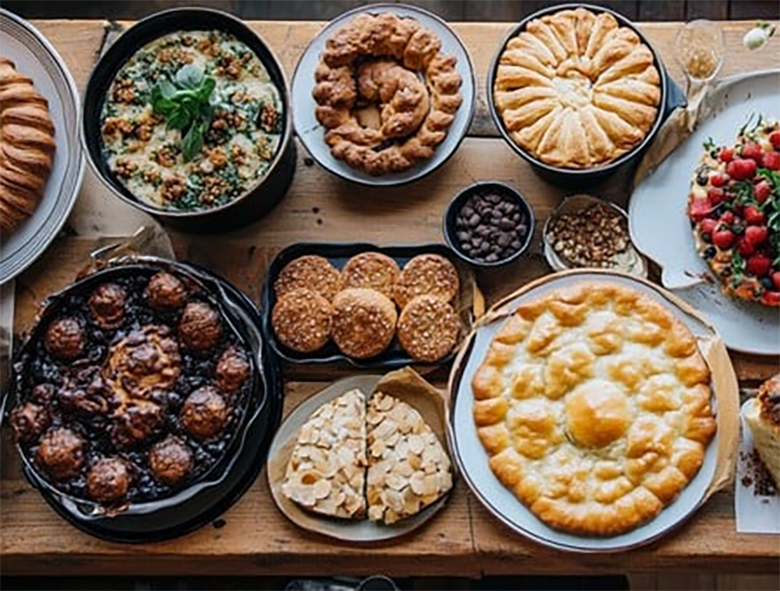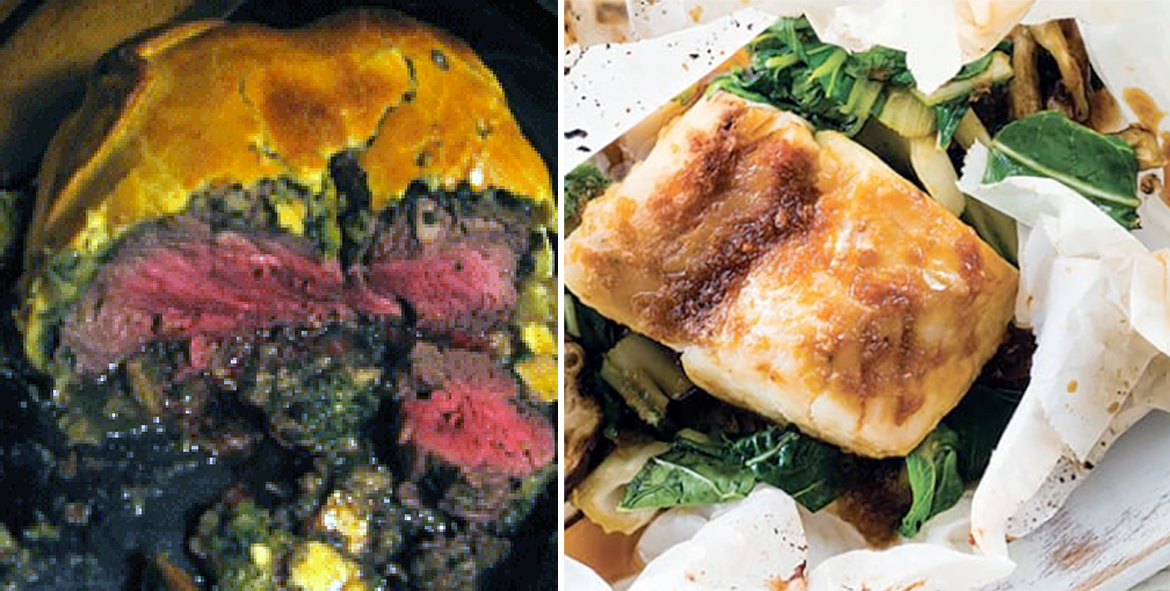FabulousFusionFood's Baking Recipes 14th Page
 A range of baked goods.
A range of baked goods.
Welcome to FabulousFusionFood's Baking Recipes Page — This is a continuation of an entire series of pages that will, I hope, allow my visitors to better navigate this site. As well as displaying recipes by name, country and region of origin I am now planning a whole series of pages where recipes can be located by meal type and main ingredient. This page gives a listing of all the baking recipes added to this site. Baking is defined as a technique for the prolonged cooking of food using dry heat by the action of conduction. Baking is normally done in an oven, but goods may also be baked in hot ashes or on hot stones. Baking differs from Roasting Recipes in that a lower temperature is typically used and the items are cooked for a longer period of time. Baking is a much older process than most people think and foods were probably originally baked in embers or with hot stones (which is how bread may have started). Only later did specialist ovens develop. Though most baked goods tend to be bread or cake-based some other dishes such as pasta dishes and vegetable dishes may also be baked. Stews are often also technically baked in an oven, but are not classed as 'baked goods' in that they are more liquid than solid at the end of the cooking process.
Baking is a method of preparing food that uses dry heat, typically in an oven, but can also be done in hot ashes, or on hot stones. The most common baked item is bread, but many other types of foods can be baked. Heat is gradually transferred "from the surface of cakes, biscuits and cookies, and pieces of bread to their centre, typically conducted at elevated temperatures surpassing 150°C. Dry heat cooking imparts a distinctive richness to foods through the processes of caramelization and surface browning. As heat travels through, it transforms batters and doughs into baked goods and more with a firm dry crust and a softer centre. Baking can be combined with grilling to produce a hybrid barbecue variant by using both methods simultaneously, or one after the other. Baking is related to barbecuing because the concept of the masonry oven is similar to that of a smoke pit.
In addition to bread, baking is used to prepare cakes, pastries, pies, tarts, quiches, biscuits and cookies, scones, crackers, pretzels, and more. These popular items are known collectively as 'baked goods', and are often sold at a bakery, which is a store that carries only baked goods, or at markets, grocery stores, farmers markets or through other venues.
 Beef en croûte (left) and fish en papillote (right).
Beef en croûte (left) and fish en papillote (right).
The alphabetical list of all the baking recipes on this site follows, (limited to 100 recipes per page). There are 2545 recipes in total:
Page 14 of 26
| Le gâteau nantais (Nantes cake) Origin: France | Lemonade Air Fryer Scones Origin: Britain | Lorna Doone Shortbread Cookies Origin: American |
| Le michon breton (Breton michon) Origin: France | Lentil Curry with Japanese Knotweed and Sweet Potatoes Origin: Fusion | Loseyns (Lozenges) Origin: England |
| Le molleux au chocolat (Chocolate Fudge Cake) Origin: France | Lentil Curry with Rhubarb and Sweet Potatoes Origin: Fusion | Lū (Baked Taro Leaf Parcels) Origin: Tonga |
| Le Vitréais, le gâteau aux pommes de Vitré (Vitré Apple Cake) Origin: France | Lepinja (Triple-raised Soft Flatbread) Origin: Serbia | Lū (Baked Taro Leaf Parcels) Origin: Wallis Fortuna |
| Leaven Origin: Ancient | Leporem farsilem (Stuffed Roast Hare with White Sauce) Origin: Roman | Lumbardy Tarts Origin: Britain |
| Leavened Bread Origin: Ancient | Les Galettes de Farine de Riz (Yeasted Rice Flour Cakes) Origin: Mali | Luncheon Cake Origin: Britain |
| Leche Asada (Baked Milk) Origin: Chile | Les Palmiers du Jour de Valentine (Palmiers for Valentine's Day) Origin: France | Lupulu (Coconut Cream and Onion in Taro Leaves) Origin: Tonga |
| Leche Frys in Lentoun (Almond Milk Fruit Pie) Origin: England | Leshes fryed in Lenton (Fried Cakes for Lent) Origin: England | Luscious Lime Cupcakes Origin: Britain |
| Ledene Kocke (Ice-cube Sponge Cake) Origin: Serbia | Lesser Celandine Straws Origin: Britain | Maandazi (Swahili Doughnuts) Origin: Tanzania |
| Leeky Larrup Origin: England | Liberian Cassava Biscuits Origin: Liberia | Mac'N'Cheese Origin: American |
| Leftover Porridge Muffins Origin: Scotland | Liberian Cassava Bread Origin: Liberia | Macadamia Nut and Toffee Tart Origin: Australia |
| Leftover Rice Muffins Origin: Britain | Liberian Cornbread Origin: Liberia | Macadamia Nut Pie Origin: Marshall Islands |
| Lemon and Condensed Milk Biscuits Origin: Botswana | Liberian Cornbread Origin: Liberia | Macadamia Tart Origin: Australia |
| Lemon and Lime Meringue Tart Origin: Britain | Liberian Pound Cake Origin: Liberia | Macaroon-topped Mince Pies Origin: British |
| Lemon and Marigold Tart Origin: Britain | Liberian Rice Bread II Origin: Liberia | Macaroons Origin: Britain |
| Lemon and Poppy Seed Muffins Origin: Britain | Liboké de Poisson (Fish in Banana Leaf) Origin: Central Africa | Macau Po Egg Tart (Pastéis de nata) Origin: Macau |
| Lemon Balm Cheesecake Origin: Britain | Libum (Sacral Bread) Origin: Roman | Machetadas (Honduran Fried Dough) Origin: Honduras |
| Lemon Basil Crème Brûlée Origin: Fusion | Libum (Diced Cheese Bread) Origin: Roman | Mackerel Pasty Origin: England |
| Lemon Cake Mix Cake Origin: American | Libyan Camel Meatballs Origin: Libya | Macrell Ceinewydd (New Quay Mackerel) Origin: Welsh |
| Lemon Cake Mix Chocolate Cake Origin: American | Licky Pasty Origin: England | Madeira Cake Origin: Britain |
| Lemon Cake Mix Spice Cake Origin: American | Licky Pie Origin: England | Madeira Cake II Origin: Britain |
| Lemon Chiffon Cake Origin: American | Lilac Honey Cake Origin: Britain | Madeira Fingers Origin: England |
| Lemon Couscous Cake Origin: African Fusion | Limelax (Lime Salmon) Origin: Sweden | Madeira Fingers Origin: England |
| Lemon Cross Buns Origin: Britain | Lincolnshire Haslet Origin: England | Mafa (Breadfruit Pudding) Origin: Marshall Islands |
| Lemon Drizzle Cake Origin: Britain | Linden Chocolate Mississippi Mud Pie Origin: American | Magic Lamb Origin: Namibia |
| Lemon Meringue Pie Origin: Britain | Linden Leaf Flour Origin: France | Magrood (Libyan Date Biscuits) Origin: Libya |
| Lemon Meringue Tart Origin: Britain | Linden Leaf Flour Bread Origin: France | Maids of Honour Tarts Origin: Britain |
| Lemon Pepper Seasoning Origin: Britain | Ling Fillets with Parsley and Tomato Pesto Origin: Britain | Maisbrot aus Namibia (Namibian-style Cornbread) Origin: Namibia |
| Lemon Poppy Seed Cake Origin: British | Linzer Torte Origin: Germany | Maize Flour Bread Origin: American |
| Lemon Ribwort Plantain Seed Pudding Origin: Britain | Liv Syrnyk (Easter Cheesecake with Sultanas) Origin: Ukraine | Makaronia Pastitsio (Macaroni with Minced Meat and Bechamel Sauce) Origin: Cyprus |
| Lemon Surprise Pudding Origin: Britain | Llysiau Gyda Saws Caws (Vegetables in a Cheese Sauce) Origin: Welsh | Make-ahead Mulled Wine Cake Origin: Britain |
| Lemon Whiskey Cake Origin: Ireland | Lobster and Clotted Cream Tart Origin: Britain | Makerouns (Macaroni) Origin: England |
| Lemon Whisky Cake Origin: Ireland | Locustas Assas sic Facies (Roast Lobster is Made Thus) Origin: Roman | |
| Lemon-soaked Pound Cake Origin: American | Lontar Khas (Papuan Twitching Cake) Origin: Papua |
Page 14 of 26